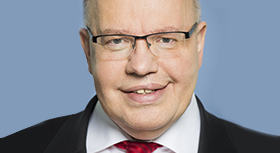You can subscribe to the Energy Transition
Order the international edition of the "Energiewende direkt" Newsletter here.
Germany wants to more than halve its greenhouse gas emissions by 2030 compared to 1990. This ambitious goal was reaffirmed in the National Energy and Climate Plan (NECP) adopted in mid-June.
Find out moreThe WERAN research project is examining the effects of wind energy installations on radio navigation facilities used by air traffic. The results will allow accurate predictions about potential disruptive effects to be made during the planning phase of new wind farms.
Find out moreGermany's National Energy and Climate Plan (NECP) was adopted in early June and submitted to the EU Commission. The NECPs allow the European Member States' energy and climate policies to be compared and coordinated for the first time.
Find out more
'The time for hydrogen and the technologies enabling its use has come. We must therefore harness the potential for economic output, employment, and the climate, and do this now. Hydrogen will be a key feedstock for a successful energy transition.'
said Peter Altmaier, Federal Minister for Economic Affairs and Energy, speaking about the Federal Government's hydrogen strategy in mid-June
This time in 'what the press say': Hydrogen wherever you look – why several EU states, including Germany, are now demanding hydrogen plans from the EU Commission; how hydrogen can be produced at sea and how Germany now wants to 'hit the gas on' its hydrogen strategy.
Find out moreHow can Germany make the energy transition a success? How can an energy supply that is largely based on renewables be ensured for the entire country in an environmentally acceptable, secure and economically efficient manner? To answer these questions around 300 project partners are working in five model regions as part of the SINTEG project. These showcase regions are: C/sells, Designetz, enera, NEW 4.0 und WindNODE. They allow a glimpse into the world of the energy of tomorrow. It is the work of the project partners at universities, research facilities, institutes, companies, associations and foundations that makes SINTEG a success every day. Serving as representatives for hundreds of other experts involved, a number of those working on those projects have been selected to be presented on the website of the Federal Ministry for Economic Affairs and Energy as part of an exposé on the 'Menschen hinter der Steckdose von SINTEG' (The people powering SINTEG, in German only).
Germany is on the way to even greater energy efficiency. The Federal Government's dialogue process entitled '2050 Energy Efficiency Roadmap' marks the beginning of another part of the 2050 Energy Efficiency Strategy, which was adopted at the end of 2019. The roadmap is based on the European goal of climate neutrality by 2050 and describes how this target can be achieved. Representatives from science, business and civil society are exchanging their knowledge and ideas to develop further instruments and measures for increasing energy efficiency. These include measures for the various sectors such as buildings, energy and transport, and cross-sectoral measures in the areas of digitalisation, training and skilled workers. They also address cross-sectoral system issues. These measures are then to supplement the National Action Plan on Energy Efficiency (NAPE). In autumn 2022, the Federal Government intends to adopt a strategy paper on the 'Development paths of energy efficiency up to 2050' (in German only).
In response to the economic consequences of the coronavirus, Germany is to introduce a 130 billion euro stimulus package. On 3 June 2020, the Coalition Committee agreed on the relevant key points and on targeted measures. The economic stimulus package is primarily intended to strengthen demand, safeguard employment and stabilise it in a targeted manner, promote investments by companies and local authorities and advance the modernisation of the country based on a forward-looking stimulus plan. Important energy policy parameters include the reduction of the surcharge on renewable energy in 2021/2022 and an increase in the CO2 Building Modernisation Programme for 2020/2021. Lower-emission and zero-emission vehicles are to be promoted, for example, by accelerating the expansion of the charging station infrastructure, doubling the existing purchase premium ('innovation premium') for electric cars and making additional investments in battery cell production, as well as by basing the motor vehicle tax more strongly on carbon emissions. As a next step, the agreed plans and measures will be discussed by the Federal Cabinet (in German only).
Order the international edition of the "Energiewende direkt" Newsletter here.